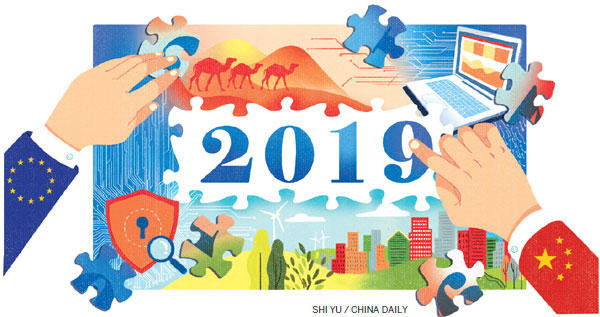Practical steps to walk their digital talk
China, EU can enhance their cooperation under their respective connectivity plans by focusing on tourism and e-health.
By Luigi Gambardella
Counting down to midnight, ringing bells and making New Year resolutions, this is how we greet a brand-new year. For Europe and China, the beginning of 2019 also marks the right time for setting new goals, particularly in the promising digital sector.

It is no surprise that both Europe and China highly value the important role digitalization plays in connectivity against the backdrop of the new wave of technological innovations, nor that they have jointly decided to back each other's efforts to seek international cooperation in the digital arena.
As Brussels and Beijing have made clear, China's Belt and Road Initiative and the European Union's intercontinental plan, titled "Connecting Europe and Asia: The EU Strategy," are anything but rivalries, and that's also true of their digital connectivity ambitions.
In 2019, many opportunities await Europe and China to boost their digital cooperation under the Belt and Road Initiative and the EU's Europe-Asia connectivity strategy, but new efforts to advance those strategies are needed.
First, Europe and China should jump at the chance to further strengthen their dialogues and exchanges in the digital sector at the multilateral meetings scheduled for this year, among which the most important is the second Belt and Road Forum for International Cooperation, slated to take place in April.
The forum is set to bring great opportunities for wider China-EU cooperation on connectivity, and digitalization is expected to be at the top of the agenda.
Addressing the first Belt and Road Forum in May 2017, President Xi Jinping told the audience from more than 100 countries- including 29 national leaders - that Beijing seeks to build a digital Silk Road.
The second forum in April will be an occasion of great significance to renew the commitments made on digital cooperation. Other high-level bilateral and international meetings, including the annual China-EU summit, which usually takes place in the summer and the 2019 G20 meetings can also be used to cement cooperation.
Next, established bilateral or multilateral links between China and European countries can facilitate the synergies between the Belt and Road Initiative and the EU's Eurasian connectivity strategy. For instance, Brussels and Beijing should make the most of the"16+1" mechanism between China and the Central and Eastern European countries, or the Italian government's China Task Force, which aims to position Rome as "a privileged partner" in the Belt and Road Initiative, to jointly work on their connectivity plans in the digital sector.
They can also make tangible steps to walk the talk. The two sides can cofund some projects to improve infrastructure for digitalization, bolster their e-commerce ties via cooperation on customs, logistics and so on, or facilitate companies from both continents having greater access to the other's digital market.
In the meantime, their coordination on the EU's General Data Protection Regulation, or GDPR, is a must for businesses in both Europe and China, their tech companies in particular.
Last but not least, China and the EU should work together to unleash the potential in specific areas. There exists a wide range of possibilities but the two should pay special attention to two fields that are embracing tremendous opportunities: tourism and e-health.
Both sectors represent vast markets with impressive potential. In tourism, China has for years been a top spender in the global market. In 2017, Chinese outbound visitors laid out $258 billion in total. Meanwhile, turning digital has forged a new trend as Chinese travelers tend to use online channels to get information and book trips while platforms such as Alipay and WeChat Pay become the norm, especially among younger travelers.
And to many observers, the e-health market in the world's second-largest economy is phenomenal. According to data from the consulting company iResearch, from 2009 to 2016, the size of China's Internet-plus healthcare market has surged from 200 million yuan (about $29 million) to 22.3 billion yuan. Although the growth rate of the industry has slowed in the past two years, it has remained at around 40 percent.
The e-health sector is expected to account for a big share of China's healthcare market that, according to a report from consulting firm McKinsey& Co, is projected to grow to $1 trillion in 2020.
More important, building better digital links between China and Europe in the tourism and e-health sectors may be one of the direct ways to benefit Chinese and European people from every walk of life. In the end, both the Belt and Road Initiative and the EU's connectivity strategy are meant to bridge the divide, promote mutual understanding and serve the interests of their people.
The author is president of ChinaEU.

